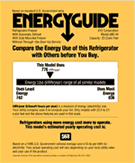Clothes Dryers
In This Guide
Get Rebates,
Incentives & Services
Introduction
Clothes dryers are typically one of the most expensive home appliances to operate, accounting for about 6% of total electricity usage. Unlike other appliances, clothes dryers don't vary much from model to model in the amount of energy used and are not required to display EnergyGuide labels. However, that doesn't mean that the amount of energy used by clothes dryers isn't important.
It typically costs 32 to 41 cents to dry a load of laundry in an electric dryer and approximately 15 to 33 cents in a gas dryer, depending on the size of the load and fabric consistency. Over its expected lifetime of 18 years, the average clothes dryer will cost you approximately $1,530 to operate. To minimize your annual operation cost, choose a clothes dryer with the right design features and operate it efficiently.
Technology Options
All dryers work essentially the same way — they tumble clothes through heated air to remove moisture. But there are two ways to create the heat needed to dry clothes — gas or electricity.
Electric dryers use heating coils to supply heat. Gas dryers use a gas burner. Gas dryers cost approximately $50 more to purchase than electric models, but since natural gas is generally cheaper than electricity, gas dryers cost less to run over their lifetime. Depending on the current utility rate, a gas dryer can save you more than $100 per year over the course of its 13-year life span.
The energy efficiency of a clothes dryer is measured by a term called the Energy Factor (EF), measured in pounds of clothing per kilowatt-hour (kWh) of electricity. The federal standard minimum EF for a standard capacity electric dryer is 3.01. For gas dryers, the minimum EF is 2.67. (The rating for gas dryers is provided in kilowatt-hours, even though the primary source of fuel is natural gas.)
Many new clothes dryers have moisture sensors in the drum for sensing dryness, while most only estimate dryness by sensing the temperature of the exhaust air. With a moisture sensor, your dryer will turn off when the humidity in the drum is removed. Compared with timed drying, you can save about 10% with a temperature sensing control and 15% with a moisture sensing control.
| Operate to Maximize Efficiency | ||
|
||
Efficiency Benefits
A gas dryer can finish three loads of laundry for the same energy costs that an electrical dryer uses to do only one, saving you up to 50% in laundry-related energy costs. If the dryer has a moisture sensor, you can save an additional 15%. The cost of drying a typical load of laundry in a gas dryer is 15 to 33 cents, while an electric dryer uses 32 to 41 cents. Gas dryers tend to operate at a hotter setting than electric ones, so clothes will tumble in the dryer for shorter periods, sparing the material and reducing energy costs. Gas dryers are slightly more expensive than electric dryers as they require a gas line hook-up installation, but since they are more energy efficient and cost less to run, you can generally re-coup the difference in the cost within a year or two.
Manufacturers
Four brands — GE, Maytag, Kenmore (Sears) and Whirlpool — account for just over 80% of dryer sales. Other brands include Amana (owned by Maytag), Frigidaire (owned by Electrolux), Hotpoint (made by General Electric), KitchenAid and Roper (both made by Whirlpool).
Purchasing Tips
|
||
Emerging Technology
Clothes for dinner? Microwave clothes dryers work on the same principle as a microwave oven. Instead of passing warm air over the clothes, microwaves directly evaporate all water present in the laundry. Microwave clothes dryers use about 17 to 25% less energy and dry clothes about 25% faster than conventional electric air dryers. To avoid the problems with metal objects, prototypes switch to electric resistance heaters when the clothes are almost dry. These new dryers cost from $30 to $395 more than conventional models, and technical issues need to be resolved before these are available on the market.
Heat-pump dryers. Heat-pump dryers use a refrigerant cycle to dehumidify the recapture heat from the exhausted air, which is then recycled through the dryer. Heat-pump dryers look like conventional dryers but require only 100 to 120 V power and can be installed anywhere in the house. These units may save 60% of the energy required to dry clothes conventionally, but may cost $300 more than a new gas dryer. They are currently in a prototype stage for residential applications.











